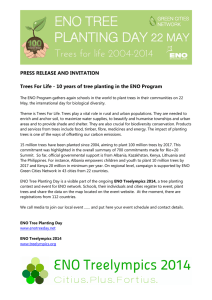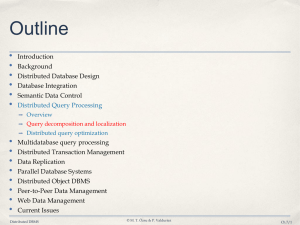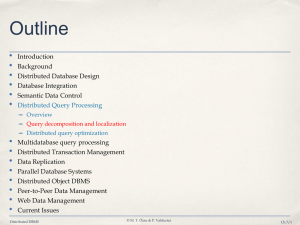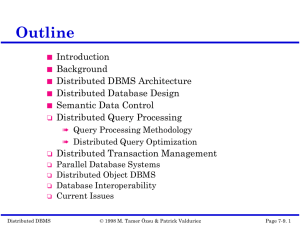slides
advertisement
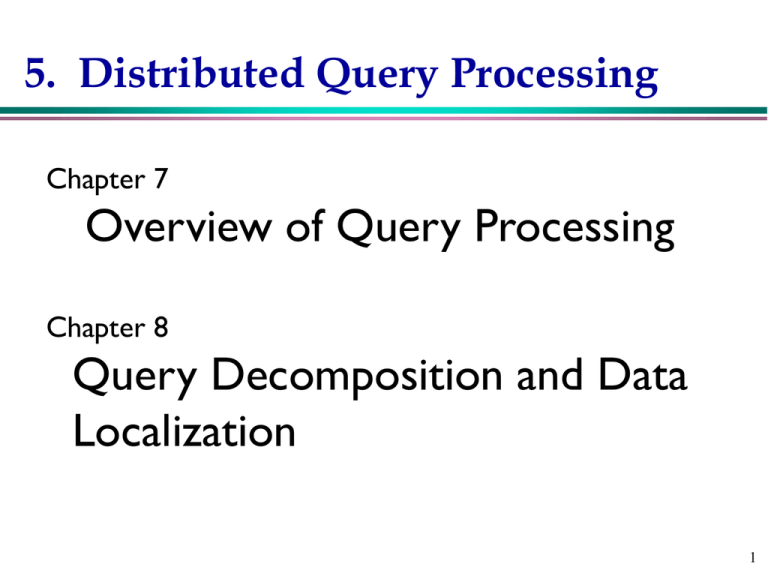
5. Distributed Query Processing
Chapter 7
Overview of Query Processing
Chapter 8
Query Decomposition and Data
Localization
1
Outline
Overview of Query Processing (查询处理)
Query Decomposition and Localization (查询分解
与定位)
2
Query Processing
High level user query
Query
Processor
Low level data manipulation commands
3
Query Processing Components
Query language that is used
SQL (Structured Query Language)
Query execution methodology
The steps that the system goes through in executing
high-level (declarative) user queries
Query optimization
How to determine the “best” execution plan?
4
Query Language
Tuple
calculus: { t | F(t) }
where t is a tuple variable, and F(t) is a well formed formula
Example:
Get the numbers and names of all managers.
t ENO, ENAME | t EMP t TITLE " MANAGER"
5
Query Language (cont.)
Domain
calculus: x1, x2 , , xn | F x1, x2 , , xn
where xi is a domain variable, and F x1, x2 , , xn is a well
formed formula
Example:
{ x, y | EMP(x, y, “Manager") }
Variables are position sensitive!
6
Query Language (cont.)
SQL
is a tuple calculus language.
SELECT ENO,ENAME
FROM
EMP
WHERE
TITLE=“Programmer”
End user uses non-procedural (declarative)
languages to express queries.
7
Query Processing Objectives & Problems
Query
processor transforms queries into procedural
operations to access data in an optimal way.
Distributed
query processor has to deal with query
decomposition and data localization.
8
Centralized Query Processing
Alternatives
SELECT ENAME
FROM
EMP E, ASG G
WHERE
E.ENO = G.ENO AND TITLE=“manager”
Strategy
1:
ENAME TITLE "manager " E.ENOG.ENO E G
Strategy
2:
ENAME E ENO TITLE "manager " G
Strategy 2 avoids Cartesian product, so is “better”.
9
Distributed Query Processing
Query
processor must consider the communication
cost and select the best site.
The
same query example, but relation G and E are
fragmented and distributed.
10
Distributed Query Processing
Plans
By centralized optimization,
Two distributed query processing plans
ENAME E ENO TITLE "manager " G
11
11
Distributed Query Plan I
Plan I: To transport all segments to query site and
execute there.
Site 5
Result = (EMP1 EMP2)
ASG1
Site 1
ASG2
Site 2
⋈ ENO TITLE=“manager” (ASG1 ASG2)
EMP1
Site 3
EMP2
Site 4
This causes too much network traffic, very costly.
12
Distributed Query Plan II
Plan II (Optimized):
Site 5
Result = (EMP1 ’ EMP2 ’)
EMP1’
Site 3
EMP1’ = EMP1
Site 4
⋈ENO ASG1’
EMP2’ = EMP2
ASG1’
Site 1
ASG1’ = TITLE=“manager” (ASG1)
EMP2’
⋈ENO ASG2’
ASG2’
Site 2
ASG2’ = TITLE=“manager” (ASG2)
13
Costs of the Two Plans
Assume:
size(EMP)=400, size(ASG)=1000, 20 tuples with TITLE=“manager”
tuple access cost = 1 unit; tuple transfer cost = 10 units
ASG and EMP are locally clustered on attribute TITLE and ENO, respectively.
Plan 1
Transfer EMP to site 5: 400*tuple transfer cost
Transfer ASG to site 5: 1000*tuple transfer cost
Produce ASG’: 1000*tuple access cost
Join EMP and ASG’: 400*20*tuple access cost
Total cost
4000
10000
1000
8000
23,000
Plan 2
Produce ASG’: (10+10)*tuple access cost
Transfer ASG’ to the sites of EMP: (10+10)*tuple transfer cost
Produce EMP’: (10+10)*tuple access cost * 2
Transfer EMP’ to result site: (10+10)*tuple transfer cost
Total cost
20
200
40
200
460
14
Query Optimization Objectives
Minimize
a cost function
I/O cost + CPU cost + communication cost
These might have different weights in different distributed
environments
Can also maximize throughout
15
Communication Cost
Wide area network
Communication cost will dominate
-
Low bandwidth
-
Low speed
-
High protocol overhead
Most algorithms ignore all other cost components
Local
area network
Communication cost not that dominate
Total cost function should be considered
16
Complexity of Relational Algebra
Operations
Measured
by cardinality n and tuples are sorted
on comparison attributes
, (without duplicate elimination)
O(n)
(with duplicate elimination), GROUP
O(nlogn)
Join, Semijoin, Division, , ,
O(nlogn)
Cartesian-Product X
O(n2)
17
Types of Query Optimization
Exhaustive
search
Cost-based
Optimal
Combinatorial complexity in the number of relations
Workable for small solution spaces
Heuristics
Not optimal
Re-group common sub-expressions
Perform selection and projection ( , ) first
Replace a join by a series of semijoins
Reorder operations to reduce intermediate relation size
Optimize individual operations
18
Query Optimization Granularity
Single
query at a time
Cannot use common intermediate results
Multiple
queries at a time
Efficient if many similar queries
Decision space is much larger
19
Query Optimization Timing
Static
Do it at compilation time by using statistics, appropriate
for exhaustive search, optimized once, but executed
many times.
Difficult to estimate the size of the intermediate results
Can amortize over many executions
Dynamic
Do it at execution time, accurate about the size of the
intermediate results, repeated for every execution,
expensive.
20
Query Optimization Timing (cont.)
Hybrid
Compile using a static algorithm
If the error in estimate size > threshold, re-optimizing at
run time
21
Statistics
Relation
Cardinality
Size of a tuple
Fraction of tuples participating in a join with another relation
Attributes
Cardinality of the domain
Actual number of distinct values
Common
assumptions
Independence between different attribute values
Uniform distribution of attribute values within their domain
22
Decision Sites
For
query optimization, it may be done by
Single site – centralized approach
– Single site determines the best schedule
– Simple
– Need knowledge about the entire distributed database
All the sites involved – distributed approach
– Cooperation among sites to determine the schedule
– Need only local information
– Cost of operation
Hybrid – one site makes major decision in cooperation
with other sites making local decisions
– One site determines the global schedule
– Each site optimizes the local subqueries
23
Network Topology
Wide
Area Network (WAN) – point-to-point
Characteristics
– Low bandwidth
– Low speed
– High protocol overhead
Communication cost will dominate; ignore all other cost
factors
Global schedule to minimize communication cost
Local schedules according to centralized query
optimization
24
Network Topology (cont.)
Local
Area Network (LAN)
communication cost not that dominate
Total cost function should be considered
Broadcasting can be exploited
Special algorithms exist for star networks
25
Other Information to Exploit
Using
replications to minimize communication costs
Using
semijoins to reduce the size of operand
relations to cut down communication costs when
overhead is not significant.
26
Layers of Query Processing
Calculus Query on Distributed Relations
QUERY
DECOMPOSITION
CONTROL
SITE
GLOBAL
SCHEMA
Algebra Query on Distributed Relations
DATA
LOCALIZATION
FRAGMENT
SCHEMA
Fragment Query
GLOBAL
OPTIMIZATION
LOCAL
SITE
Optimized Fragment Query
With Communication Operations
LOCAL
OPTIMIZATION
Optimized Local Queries
STATISTICS ON
FRAGMENTS
LOCAL
SCHEMA
27
Step 1 - Query Decomposition
Decompose calculus query into algebra query using
global conceptual schema information.
(1) normalization
(2) analysis
(3) elimination of redundancy
(4) rewriting
28
Step 1 - Query Decomposition
(cont.)
1) Normalization
The calculus query is written in a normalized form (CNF or
DNF) for subsequent manipulation
2) Analysis
To reject normalized queries for which further processing
is either impossible or unnecessary (type incorrect or
semantically incorrect)
3) Simplification
Redundant predicates are eliminated to obtain simplified
queries
4) Restructuring
The calculus query is translated to optimal algebraic query
representation
29
More than one translation is possible
1) Normalization
Lexical and syntactic analysis
check validity (similar to compilers)
check for attributes and relations
type checking on the qualification
There are two possible forms of representing the
predicates in query qualification:
Conjunctive Normal Form (CNF) or Disjunctive Normal
Form (DNF)
– CNF: (p11 p12 ... p1n) ... (pm1 pm2 ... pmn)
– DNF: (p11 p12 ... p1n) ... (pm1 pm2 ... pmn)
– OR's mapped into union
– AND's mapped into join or selection
30
1) Normalization (cont.)
The transformation of the quantifier-free predicate is
straightforward using the well-known equivalence rules for
1.
logical operations ( ):
2.
P1 P2 P2 P1
3.
P1 P2 P2 P1
4.
P1 ( P2 P3 ) ( P1 P2 ) P3
5.
P1 ( P2 P3 ) ( P1 P2 ) P3
6.
P1 ( P2 P3 ) ( P1 P2 ) P3
7.
P1 ( P2 P3 ) ( P1 P2 ) ( P1 P3 )
8.
P1 ( P2 P3 ) ( P1 P2 ) ( P1 P3 )
9. ( P1 P2 ) P1 P2
10. ( P1 P2 ) P1 P2
( P1 ) P1
31
1) Normalization (cont.)
Example
SELECT
ENAME
FROM
EMP, ASG
WHERE
EMP.ENO=ASG.ENO AND ASG.JNO=”J1”
AND (DUR=12 OR DUR=24)
The
conjunctive normal form:
EMP.ENO ASG.ENO
ASG.JNO " J 1"
( DUR 12 DUR 24)
32
2) Analysis
Objective
reject type incorrect or semantically incorrect queries.
Type incorrect
if any of its attribute or relation names is not defined in
the global schema;
if operations are applied to attributes of the wrong type
33
2) Analysis (cont.)
Type
incorrect example
SELECT
E#
FROM
EMP
WHERE
ENAME>200
! Undefined
attribute
! Type
mismatch
34
2) Analysis (cont.)
Semantically incorrect
Components do not contribute in any way to the
generation of the result
For only those queries that do not use disjunction () or
negation (), semantic correctness can be determined by
using query graph
35
Query Graph
Two
kinds of nodes
One node represents the result relation
Other nodes represent operand relations
Two
types of edges
an edge to represent a join if neither of its two nodes is
the result
an edge to represent a projection if one of its node is
the result node
Nodes and edges may be labeled by
predicates for selection, projection, or join.
36
Query Graph Example
SELECT
FROM
WHERE
ENAME, RESP
EMP,ASG,PROJ
EMP.ENO=ASG.GNO
AND ASG.PNO=PROJ.PNO AND PNAME=“CAD/CAM”
AND DUR>36
AND TITLE=“Programmer”
37
Join Graph Example 1
A subgraph of query graph for join operation.
38
Tool of Analysis
A conjunctive query without negation is
semantically incorrect if its query graph is NOT
connected!
39
Analysis Example
Example 2
SELECT
FROM
WHERE
AND
AND
AND
AND
ENAME, RESP
EMP,ASG,PROJ
EMP.ENO=ASG.GNO
ASG.PNO=PROJ.PNO
PNAME=“CAD/CAM”
DUR>36
TITLE=“Programmer”
40
Query Graph Example 2
41
3) Simplification
Using
idempotency
rules to eliminate
redundant predicates
from WHERE clause.
P P P
P P P
P true P
P false P
P false false
P true true
P P false
P P true
P1 ( P1 P2 ) P1
P1 ( P1 P2 ) P1
42
Simplification Example
SELECT TITLE
FROM EMP
WHERE (NOT(TITLE=”Programmer)
AND (TITLE=“Programmer”
OR
TITLE=“Electrical Eng.”)
AND NOT(TITLE=“Electrical Eng.”))
OR ENAME=“J.Doe”
is equivalent to
SELECT TITLE
FROM
EMP
WHERE ENAME="J.Doe"
43
Simplification Example (cont.)
p1 = <TITLE = ``Programmer''>
p2 = <TITLE = ``Elec. Engr''>
p3 = <ENAME = ``J.Doe''>
Let the query qualification is
(¬ p1 (p1 p2) ¬ p2) p3
The disjunctive normal form of the query is
= (¬ p1 p1 ¬p2) (¬ p1 p2 ¬ p2) p3
= (false ¬ p2) (¬ p1 false) Ú p3
= false false p3
= p3
44
4) Rewriting
Converting
a calculus query in relational algebra
straightforward transformation from relational calculus
to relational algebra
restructuring relational algebra expression to improve
performance
making use of query trees
45
Relational Algebra Tree
A
tree defined by:
a root node representing the query result
leaves representing database relations
non-leaf nodes representing relations produced by
operations
edges from leaves to root representing the sequences
of operations
46
An SQL Query and Its Query Tree
ENAME
(ENAME<>“J.DOE” )(JNAME=“CAD/CAM” ) (Dur=12 Dur=24)
SELECT
FROM
WHERE
AND
AND
AND
Ename
J, G, E
G.Eno=E.ENo
G.JNo = J.JNo
ENAME <> `J.Doe'
JName = `CAD'
JNO
ENO
PROJ
AND (Dur=12 or Dur=24)
ASG
EMP
47
How to translate an SQL query into
an algebra tree?
1. Create a leaf for every relation in the FROM
clause
2. Create the root as a project operation involving
attributes in the SELECT clause
3. Create the operation sequence by the predicates
and operators in the WHERE clause
48
Rewriting -- Transformation Rules (I)
Commutativity of binary operations:
RS SR
R
S S
R
RS SR
Associativity of binary operations:
(R S) T R ( S T )
(R
S) T R
(S T)
Idempotence of unary operations: grouping of projections
and selections
A’ ( A’’ (R )) A’ (R ) for A’A’’ A
p1(A1) ( p2(A2) (R )) p1(A1) p2(A2) (R )
49
Rewriting -- Transformation Rules (II)
Commuting selection with projection
A1, …, An ( p (Ap) (R )) A1, …, An ( p (Ap) ( A1, …, An, Ap(R )))
Commuting selection with binary operations
p (Ai)(R S) ( p (Ai)(R)) S
p (Ai)(R
S) ( p (Ai)(R))
S
p (Ai)(R S) p (Ai)(R) p (Ai)(S)
Commuting projection with binary operations
C(R S) A(R) B (S) C = A B
C(R
S) C(R)
C (S)
C (R S) C (R) C (S)
50
How to use transformation rules to
optimize?
Unary
operations on the same relation may be
grouped to access the same relation once
Unary
operations may be commuted with binary
operations, so that they may be performed first
to reduce the size of intermediate relations
Binary
operations may be reordered
51
Optimization of Previous Query
Tree
52
Step 2 : Data
Localization
Task
: To translate
a query on global
relation into algebra
queries on physical
fragments, and
optimize the query
by reduction.
53
Data Localization-- An Example
EMP is fragmented into
EMP1 = ENO “E3” (EMP)
EMP2 = “E3” < ENO “E6” (EMP)
EMP3 = ENO >“E6” (EMP)
ENAME
Dur=12 Dur=24
ENAME<>“J.DOE”
ASG is fragmented into
ASG1 = ENO “E3” (ASG)
ASG2 = ENO >“E3” (ASG)
JNAME=“CAD/CAM”
JNO
ENO
PROJ
ASG1
ASG2 EMP1
EMP2
EMP3
54
Reduction with Selection for PHF
SELECT *
FROM EMP
WHERE ENO=“E5”
EMP is fragmented into
EMP1 = ENO “E3” (EMP)
EMP2 = “E3” < ENO “E6” (EMP)
EMP3 = ENO >“E6” (EMP)
Given Relation R, FR={R1, R2, …, Rn} where Rj =pj(R)
pj(Rj) = if x R: (pi(x)pj(x))
ENO=“E5”
ENO=“E5”
EMP
ENO=“E5”
EMP1
EMP2
EMP3
EMP2
55
Reduction with Join for PHF
SELECT *
FROM EMP, ASG
WHERE EMP.ENO=ASG.ENO
ENO
ENO
ASG1
ASG
ASG2 EMP1
EMP2
EMP3
EMP
ASG is fragmented into
ASG1 = ENO “E3” (ASG)
ASG2 = ENO >“E3” (ASG)
EMP is fragmented into
EMP1 = ENO “E3” (EMP)
EMP2 = “E3” < ENO “E6” (EMP)
EMP3 = ENO >“E6” (EMP)
56
Reduction with Join for PHF (I)
(R1 R2)
S
(R1
S) (R2
ENO
ASG1
ASG2 EMP1
EMP2
S)
EMP3
ENO
ENO
ENO
ENO
ENO
ENO
EMP1 ASG1 EMP1 ASG2 EMP2 ASG1 EMP2 ASG2 EMP3 ASG1 EMP3 ASG2
57
Reduction with Join for PHF (II)
ENO
EMP1 ASG1
ENO
EMP2 ASG2
ENO
EMP3 ASG2
Given Ri =pi(R) and Rj =pj(R)
Ri
Rj = if x Ri , y Rj: (pi(x)pj(y))
Reduction with join
1. Distribute join over union
2. Eliminate unnecessary work
58
Reduction for VF
Find useless intermediate relations
Relation R defined over attributes A = {A1, A2, …, An}
vertically fragmented as Ri =A’ (R) where A’ A
D (Ri) is useless if the set of projection attributes D is
not in A’
EMP1= ENO,ENAME (EMP)
EMP2= ENO,TITLE (EMP)
SELECT ENAME
FROM EMP
ENAME
ENAME
ENO
EMP1
EMP2
EMP1
59
Reduction for DHF
Distribute joins over union
Apply the join reduction for horizontal fragmentation
EMP1: TITLE=“Programmer” (EMP)
EMP2: TITLE“Programmer” (EMP)
ASG1: ASG
ENO EMP1
ASG2: ASG
ENO EMP2
SELECT *
ASG1
FROM EMP, ASG
WHERE ASG.ENO = EMP.ENO
AND EMP.TITLE = “Mech. Eng.”
ENO
TITLE=“MECH. Eng.”
ASG2 EMP1
EMP2
60
Reduction for DHF (II)
ENO
Selection first
Joins over union
TITLE=“Mech. Eng.”
ASG1
ASG2
EMP2
ENO
ENO
TITLE=“Mech. Eng.”
ASG2
ASG1
EMP2
TITLE=“Mech. Eng.”
ASG1
EMP2 ASG1
ASG2
ENO
TITLE=“Mech. Eng.”
EMP2
61
Reduction for Hybrid Fragmentation
Combines the rules already specified:
Remove empty relations generated by contradicting
selection on horizontal fragments;
Remove useless relations generated by projections on
vertical fragments;
Distribute joins over unions in order to isolate and
remove useless joins.
62
Reduction for Hybrid Fragmentation
- Example
EMP1 = ENO“E4” (ENO,ENAME (EMP))
EMP2 = ENO>“E4” (ENO,ENAME (EMP))
EMP3 = ENO,TITLE (EMP)
ENAME
ENAME
QUERY:
SELECT ENAME
FROM EMP
WHERE ENO = “E5”
ENO=“E5”
ENO=“E5”
EMP2
ENO
EMP1
ASG1 EMP2 EMP3
63
Question & Answer
64


